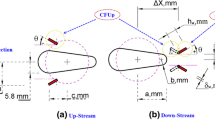Abstract
An experimental and numerical study has been conducted to clarify fluid flow characteristics and pressure drop distributions of a cross-flow heat exchanger employing staggered wing-shaped tubes at different angels of attack. The water-side Rew and the air-side Rea were at 5 × 102 and at from 1.8 × 103 to 9.7 × 103, respectively. Three cases of the tubes arrangements with various angles of attack, row angles of attack and 90° cone angles were employed at the considered Rea range. Correlation of pressure drop coefficient Pdc in terms of Rea, design parameters for the studied cases were presented. The flow pattern around the staggered wing-shaped tubes bundle were predicted using the commercial CFD FLUENT 6.3.26 software package. Results indicated that the values of Pdc increased with the angle of attack from 0° to 45°, while the opposite was true for angles of attack from 135° to 180°. The values of Pdc for the arrangements of (θ1,2,3 = 45°), (θ1 = 45°, θ2 = 0°, θ3 = 45°), and (θ1,2,3 = 0°) were lower than those for the arrangement of (ϕ1 = ϕ2 = ϕ3 = 90°) by about 33, 53, and 91 %, respectively. Comparisons between the experimental and numerical results of the present study and those obtained by similar previous studies showed good agreements.






















Similar content being viewed by others
Abbreviations
- Deq :
-
Equivalent circular diameter, m
- Pdc :
-
Pressure drop coefficient, (2 ∆Pa)/(ρaf V 2a )
- Pr:
-
Prandtl number, (μ cp)/k
- R2 :
-
Coefficient of determination ranged from 0 to 1
- Re:
-
Reynolds number, (ρ V Deq)/μ
- T:
-
Temperature, K
- V:
-
Velocity, m/s
- m:
-
Mass flow rate, kg/s
- t:
-
Tube thickness, m
- x:
-
Axial coordinate
- y:
-
The normal distance to the tube surface
- y+ :
-
Dimensionless normal distance to the tube surface
- μ:
-
Absolute viscosity, Pa s
- ρ:
-
Density, kg/m3
- θ:
-
Angle of attack, °
- θi :
-
Row angle of attack, °
- ϕi :
-
The cone angle, °
- ∆hdyn :
-
Dynamic head difference, m H2O
- ∆Pa :
-
Pressure drop across the bundle, Pa
- a:
-
Air
- c:
-
Circular
- e:
-
Exit
- f:
-
Film
- i:
-
Inlet, or row number
- o:
-
Outer or outlet
- w:
-
Water
- RNG:
-
Reynolds normalized group
References
Zhukauskas A, Ulinskas RV (1985) Efficiency parameters of heat transfer in tube banks. Heat Transf Eng 6(1):19–25
Brauer H (1964) Compact heat exchangers. J. Chem. Process Eng, pp. 451–460
Horvat A, Leskovar M, Mavko B (2006) Comparison of heat transfer conditions in tube bundle cross-flow for different tube shapes. Int J Heat Mass Transf 49:1027–1038
Nishiyama H, Ota T, Matsuno T (1988) Heat transfer and flow around elliptic cylinders in tandem arrangement. JASME Int J Ser II 31(3):410–419
Harris DK, Goldschmidt VW (2002) Measurement of the overall heat transfer for combustion gases confined within elliptical tube heat exchangers. Exp Therm Fluid Sci 26:33–37
Ibrahim TA, Gomma A (2009) Thermal performance criteria of elliptic tube bundle in cross flow. Int J Therm Sci 48:1–11
Ibrahiem EZ, Elsyed AO, Sayed Ahmed SE (2003) Experimental investigation of the performance of a cross flow heat exchanger with bundle of semi-circular tubes. Mansoura Eng J 28(2):134–150
Sayed Ahmed SE, Mesalhy OM, Khass TM, Hassan AH (2012) Parametric study of air cooling process via water cooled bundle of wing-shaped tubes. EIJST 15(3):1172–1184
Cengel YA (1998) Heat transfer a practical approach. McGraw-Hill, New Jersey
(2006) FLUENT 6.3 User’s guide. FLUENT Inc
Yakhot V, Orszag SA, Thangam S, Gatski TB, Speziale GG (1992) Development of turbulence models for shear flows by a double expansion technique. Phys Fluids A 4:1510–1520
Zehua H, Sun D (2000) Predicting local surface heat transfer coefficients by different turbulent k-ε models to simulate heat and moisture transfer during air-blast chilling. Int J Refrig 24(7):702–717
Zukauskas A (1972) Heat transfer from tubes in cross flow. In: Hartnett JP, Irvine TF Jr (eds) Advances in heat transfer, vol 8. Academic Press, New York, pp 93–160
Author information
Authors and Affiliations
Corresponding author
Rights and permissions
About this article
Cite this article
Sayed Ahmed, S.E., Ibrahiem, E.Z., Mesalhy, O.M. et al. Effect of attack and cone angels on air flow characteristics for staggered wing shaped tubes bundle. Heat Mass Transfer 51, 1001–1016 (2015). https://doi.org/10.1007/s00231-014-1473-3
Received:
Accepted:
Published:
Issue Date:
DOI: https://doi.org/10.1007/s00231-014-1473-3



